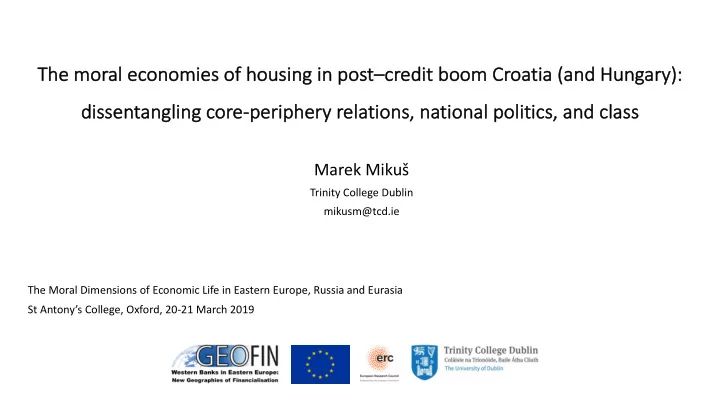

Th The mo moral economi mies of housing in post–cr credit boom m Croatia (and Hungary): di dissentang ngling ng core-pe periphe phery relations ns, na nationa nal po politics, and nd class Marek Mikuš Trinity College Dublin mikusm@tcd.ie The Moral Dimensions of Economic Life in Eastern Europe, Russia and Eurasia St Antony’s College, Oxford, 20-21 March 2019
Human Shield
Contestations of housing financialization The existing literature (mainly in geography and anthropology) focuses on: • progressive movements in the US and Western Europe (esp. Spain) • opposing housing financialization directly and radically • promoting alternative, de-financialized and de-commodified models of housing provisioning In Croatia: analogues, but within “impure” assemblages of more reformist, selective, or nationalist populist projects.
Conceptual framework • Expanding the view to practices and actors who contest housing financialization indirectly and/or selectively • Building on a radical concept of moral economy (Palomera and Vetta 2016) and its extension to housing (Alexander, Bruun and Koch 2018) • Tracing how plural and contested moral economies of housing in Croatia are shaped by political economy and interventions of multiple actors, including the state and social movements
“ Article 34 of the Constitution of the Republic of Croatia: The home is sacrosanct. ” “ More love - less evictions / Living Wall ”
Frank Association / Force
“ Stop debt slavery! ” “ CHF [Swiss franc] credit: unconstitutional, immoral, invalid! ”
Hungarian CHF debtor groups • Inclinations to nationalism and anti-elite populism • Alliances with far-right actors • Reliance on protests, eviction obstruction, and low-level legal strategies • Fragmented • Resource-poor • Modest achievements
Discussion Similarities between Croatian and Hungarian activisms: • Contesting particular lending and debt collection practices rather than housing financialization per se • Importance of individual litigation Can be traced to: • Similar super-homeownership housing regimes and peripheral financialization processes • Compared to the core, more prime borrowers subjected to subprime lending practices → more individualized debt trajectories → more reactive and selective/specialized, and less radical and all-encompassing activisms
Discussion Differences: • Hungarian movements did not become parties • None has achieved the professionalization and success of FA’s legal strategies • More muted nationalism of Croatian movements (esp. FA) Can be traced to: • Different national political hegemonies • Different framing of key issues (e.g. evictions vs predatory lending) • Different framing of constituencies (e.g. subalterns vs middle class)
Recommend
More recommend